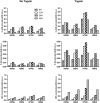Transcription factor regulation and cytokine expression following in vitro infection of primary chicken cell culture with low pathogenic avian influenza virus
- PMID: 24252391
- PMCID: PMC4225510
- DOI: 10.1186/1743-422X-10-342
Transcription factor regulation and cytokine expression following in vitro infection of primary chicken cell culture with low pathogenic avian influenza virus
Abstract
Background: Avian influenza virus (AIV) induced proinflammatory cytokine expression is believed to contribute to the disease pathogenesis following infection of poultry. However, there is limited information on the avian immune response to infection with low pathogenic avian influenza virus (LPAIV).
Methods: To gain a better understanding of the early viral-host interactions of LPAIV in chickens, primary chicken embryo hepatocytes (CEH) were infected with four different LPAIVs of U.S. origin. Kinetics of virus replication, transcription factor (c-Jun, p50 and IRF-3) activation and immune response gene (IL-6, IL-1beta, IFN-alpha and Mx) expression were studied at four different time points (6, 12, 24 and 48 hours) post infection and compared to non-infected controls.
Results: CEH can support growth of the tested LPAIVs when with trypsin supplementation. All four immune response genes tested were upregulated following infection as were transcription factors c-Jun, p50 and IRF-3. Amplification of these genes was dependant on virus replication (e.g. inclusion of trypsin), such that immune response genes and transcription factors were upregulated as viral titers increased.
Conclusion: The results of these studies demonstrate the requirement of virus replication for innate immune regulation and broaden our understanding of transcription factor responses related to LPAIV infection in chickens.
Figures




Similar articles
-
Chicken interferon alpha pretreatment reduces virus replication of pandemic H1N1 and H5N9 avian influenza viruses in lung cell cultures from different avian species.Virol J. 2011 Sep 22;8:447. doi: 10.1186/1743-422X-8-447. Virol J. 2011. PMID: 21939525 Free PMC article.
-
Susceptibility of primary chicken intestinal epithelial cells for low pathogenic avian influenza virus and velogenic viscerotropic Newcastle disease virus.Virus Res. 2016 Oct 2;225:50-63. doi: 10.1016/j.virusres.2016.09.001. Epub 2016 Sep 3. Virus Res. 2016. PMID: 27596739
-
Transcriptional analysis of the innate immune response of ducks to different species-of-origin low pathogenic H7 avian influenza viruses.Virol J. 2013 Mar 23;10:94. doi: 10.1186/1743-422X-10-94. Virol J. 2013. PMID: 23521892 Free PMC article.
-
Immune responses to avian influenza viruses in chickens.Virology. 2025 Feb;603:110405. doi: 10.1016/j.virol.2025.110405. Epub 2025 Jan 16. Virology. 2025. PMID: 39837219 Review.
-
Emerging avian influenza infections: Current understanding of innate immune response and molecular pathogenesis.Int Rev Immunol. 2017 Mar 4;36(2):89-107. doi: 10.1080/08830185.2017.1291640. Epub 2017 Mar 8. Int Rev Immunol. 2017. PMID: 28272907 Review.
Cited by
-
Comparative analysis of innate immune responses in Sonali and broiler chickens infected with tribasic H9N2 low pathogenic avian influenza virus.BMC Vet Res. 2024 Nov 1;20(1):500. doi: 10.1186/s12917-024-04346-8. BMC Vet Res. 2024. PMID: 39482682 Free PMC article.
-
P38 and JNK Mitogen-Activated Protein Kinases Interact With Chikungunya Virus Non-structural Protein-2 and Regulate TNF Induction During Viral Infection in Macrophages.Front Immunol. 2019 Apr 12;10:786. doi: 10.3389/fimmu.2019.00786. eCollection 2019. Front Immunol. 2019. PMID: 31031770 Free PMC article.
-
Immune Control of Avian Influenza Virus Infection and Its Vaccine Development.Vaccines (Basel). 2023 Mar 4;11(3):593. doi: 10.3390/vaccines11030593. Vaccines (Basel). 2023. PMID: 36992177 Free PMC article. Review.
-
Positive regulation of humoral and innate immune responses induced by inactivated Avian Influenza Virus vaccine in broiler chickens.Vet Res Commun. 2015 Dec;39(4):211-6. doi: 10.1007/s11259-015-9644-3. Epub 2015 Sep 2. Vet Res Commun. 2015. PMID: 26329833
References
-
- Kapczynski DR, Swayne DE. Influenza vaccines for avian species. Curr Top Microbiol Immunol. 2009;333:133–152. - PubMed
-
- Veits J, Weber S, Stech O, Breithaupt A, Graber M, Gohrbandt S, Bogs J, Hundt J, Teifke JP, Mettenleiter TC, Stech J. Avian influenza virus hemagglutinins H2, H4, H8, and H14 support a highly pathogenic phenotype. Proc Natl Acad Sci USA. 2012;109:2579–2584. doi: 10.1073/pnas.1109397109. - DOI - PMC - PubMed
Publication types
MeSH terms
Substances
LinkOut - more resources
Full Text Sources
Other Literature Sources
Research Materials
Miscellaneous

